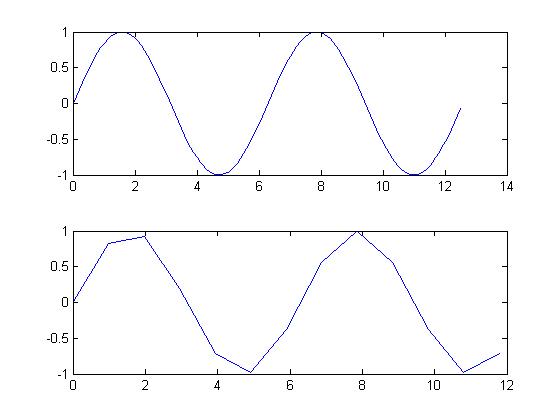(New page: == Periodic Signals ==) |
(→Periodic Signals) |
||
| (6 intermediate revisions by the same user not shown) | |||
| Line 1: | Line 1: | ||
== Periodic Signals == | == Periodic Signals == | ||
| + | |||
| + | <pre> | ||
| + | % Homework 2A Periodic Signals Revisited | ||
| + | %David Record | ||
| + | %September 3rd 2008 | ||
| + | |||
| + | %Function f(x) = sin(x) -From Max Paganini's first homework | ||
| + | %%%Make first plot | ||
| + | dt = .1; | ||
| + | time = 4*pi; | ||
| + | t = [0:dt:time]; | ||
| + | y = sin(t); | ||
| + | subplot(2,1,1); | ||
| + | plot(t,y); | ||
| + | |||
| + | %%%Make second plot | ||
| + | %Referenced code from Monil Goklani | ||
| + | dt = pi/3.2; | ||
| + | time = 4*pi; | ||
| + | t = [0:dt:time]; | ||
| + | y = sin(t); | ||
| + | subplot(2,1,2); | ||
| + | plot(t,y); | ||
| + | |||
| + | %Part 2 | ||
| + | %referenced code | ||
| + | %Function: x(t) = e^(t*j/6) | ||
| + | |||
| + | t=0.01:.01:1; | ||
| + | y=exp(t*j/6); | ||
| + | x=[] | ||
| + | for d=1:10 | ||
| + | x=[x,y]; | ||
| + | end | ||
| + | |||
| + | t=[0.01:.01:10]; | ||
| + | plot(t,x) | ||
| + | |||
| + | |||
| + | |||
| + | </pre> | ||
| + | |||
| + | [[Image:HW2A1_ECE301Fall2008mboutin.jpg]] | ||
| + | [[Image:hw2Bdr_ECE301Fall2008mboutin.jpg]] | ||
Latest revision as of 18:00, 12 September 2008
Periodic Signals
% Homework 2A Periodic Signals Revisited
%David Record
%September 3rd 2008
%Function f(x) = sin(x) -From Max Paganini's first homework
%%%Make first plot
dt = .1;
time = 4*pi;
t = [0:dt:time];
y = sin(t);
subplot(2,1,1);
plot(t,y);
%%%Make second plot
%Referenced code from Monil Goklani
dt = pi/3.2;
time = 4*pi;
t = [0:dt:time];
y = sin(t);
subplot(2,1,2);
plot(t,y);
%Part 2
%referenced code
%Function: x(t) = e^(t*j/6)
t=0.01:.01:1;
y=exp(t*j/6);
x=[]
for d=1:10
x=[x,y];
end
t=[0.01:.01:10];
plot(t,x)



